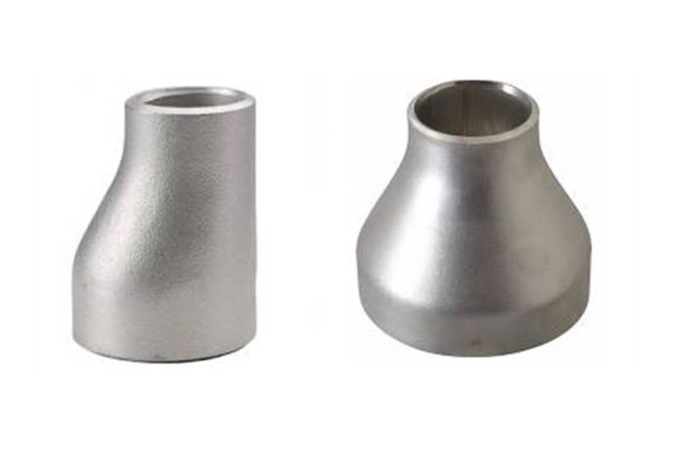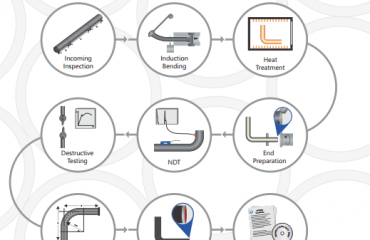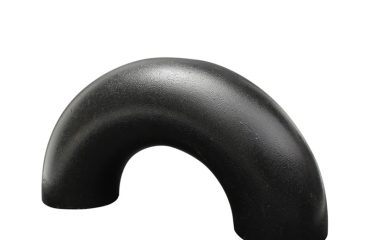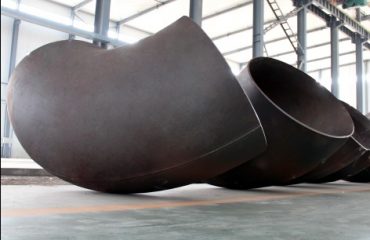
Concentric Reducer vs Eccentric Reducer: Key Differences
Introduction
In piping systems, reducers are essential components used to connect pipes of different diameters. They are primarily used to reduce the pipe size from a larger bore to a smaller bore, which helps in controlling flow rates, managing pressure drops, and adapting to different pipe sizes. There are two main types of reducers used in piping systems: concentric reducers and eccentric reducers.
While both types of reducers serve the same basic function of connecting pipes of different diameters, they differ in their design, application, and the way they handle fluid flow. In this article, we will explore the key differences between concentric reducers and eccentric reducers, their applications, and the advantages of each type.
What is a Concentric Reducer?
A concentric reducer is a type of pipe fitting that is used to join two pipes of different diameters along the same centerline. The reducer is shaped like a cone, with the larger end aligned with the smaller end, ensuring a smooth transition between the two pipe sizes. This type of reducer is commonly used in vertical piping systems where the flow direction is upward or downward.
Key Features of Concentric Reducers:
- Symmetrical Shape: The concentric reducer has a symmetrical, cone-shaped design, with both ends of the reducer aligned along the same centerline.
- Smooth Flow Transition: The conical shape of the reducer allows for a smooth transition of fluid from the larger pipe to the smaller pipe, minimizing turbulence and pressure loss.
- Common in Vertical Piping: Concentric reducers are often used in vertical piping systems where the flow direction is either upward or downward.
Applications of Concentric Reducers:
- Pumps and Compressors: Concentric reducers are commonly used at the suction and discharge sides of pumps and compressors to ensure a smooth flow of fluids.
- Vertical Piping Systems: These reducers are ideal for vertical piping systems where the flow direction is aligned with gravity or against it.
- Fluid Transportation: Concentric reducers are used in fluid transportation systems to connect pipes of different sizes while maintaining a consistent flow.
Advantages of Concentric Reducers:
- Smooth Flow: The symmetrical design of concentric reducers ensures a smooth transition of fluid, reducing the risk of turbulence and pressure drops.
- Versatility: Concentric reducers can be used in a wide range of applications, including both liquid and gas transportation systems.
- Easy Installation: The symmetrical shape of the reducer makes it easy to install in piping systems where alignment is critical.
Disadvantages of Concentric Reducers:
- Pooling in Horizontal Systems: In horizontal piping systems, concentric reducers can cause fluid pooling at the bottom of the pipe, as the reducer’s symmetrical shape can create a low point where fluids can accumulate.
What is an Eccentric Reducer?
An eccentric reducer is a type of pipe fitting that is used to join two pipes of different diameters, but unlike a concentric reducer, the eccentric reducer has an offset centerline. This means that the larger end of the reducer is not aligned with the smaller end, creating a flat side on one end of the reducer. Eccentric reducers are commonly used in horizontal piping systems where the flow direction is horizontal.
Key Features of Eccentric Reducers:
- Offset Centerline: The eccentric reducer has an offset centerline, with one side of the reducer being flat. This design helps to prevent fluid pooling in horizontal piping systems.
- Flat Side: The flat side of the eccentric reducer ensures that the bottom of the pipe remains level, preventing the accumulation of fluids or gases.
- Common in Horizontal Piping: Eccentric reducers are often used in horizontal piping systems where the flow direction is parallel to the ground.
Applications of Eccentric Reducers:
- Horizontal Piping Systems: Eccentric reducers are ideal for horizontal piping systems where it is important to prevent fluid pooling or gas pocket formation.
- Pump Suction Lines: Eccentric reducers are commonly used on the suction side of pumps to prevent air from being trapped in the piping, which can cause cavitation.
- Condenser and Heat Exchanger Piping: Eccentric reducers are used in condenser and heat exchanger piping systems to ensure proper fluid flow and prevent gas accumulation.
Advantages of Eccentric Reducers:
- Prevents Pooling: The offset design of eccentric reducers prevents fluid pooling in horizontal piping systems, making them ideal for applications where this is a concern.
- Prevents Cavitation: In pump suction lines, eccentric reducers help to prevent cavitation by ensuring that air does not become trapped in the piping.
- Improved Flow: The flat side of the eccentric reducer ensures that the flow remains smooth, reducing the risk of turbulence and pressure drops.
Disadvantages of Eccentric Reducers:
- More Complex Installation: The offset design of eccentric reducers can make them more difficult to install compared to concentric reducers, especially in systems where precise alignment is required.
- Limited Use in Vertical Systems: Eccentric reducers are not typically used in vertical piping systems, as their offset design is not necessary in these applications.
Key Differences Between Concentric Reducers and Eccentric Reducers
1. Shape and Design
- Concentric Reducer: The concentric reducer has a symmetrical, cone-shaped design, with both ends aligned along the same centerline. This creates a uniform transition between the larger and smaller pipe sizes.
- Eccentric Reducer: The eccentric reducer has an offset centerline, with one side of the reducer being flat. This design creates a non-uniform transition between the larger and smaller pipe sizes.
2. Applications
- Concentric Reducer: Concentric reducers are commonly used in vertical piping systems where the flow direction is upward or downward. They are also used in pumps and compressors to ensure a smooth flow of fluids.
- Eccentric Reducer: Eccentric reducers are typically used in horizontal piping systems where it is important to prevent fluid pooling or gas pocket formation. They are commonly used in pump suction lines and condenser piping systems.
3. Flow Characteristics
- Concentric Reducer: The symmetrical design of the concentric reducer ensures a smooth transition of fluid, minimizing turbulence and pressure loss. However, in horizontal systems, it can cause fluid pooling at the bottom of the pipe.
- Eccentric Reducer: The offset design of the eccentric reducer prevents fluid pooling and gas accumulation in horizontal piping systems, ensuring smooth flow and preventing cavitation in pump suction lines.
4. Installation Complexity
- Concentric Reducer: The symmetrical shape of the concentric reducer makes it easier to install in systems where alignment is critical. It is commonly used in both horizontal and vertical piping systems.
- Eccentric Reducer: The offset design of the eccentric reducer can make installation more complex, especially in systems where precise alignment is required. It is primarily used in horizontal piping systems.
5. Use in Horizontal vs. Vertical Systems
- Concentric Reducer: Concentric reducers are commonly used in vertical piping systems where the flow direction is aligned with gravity or against it. However, they can also be used in horizontal systems, though they may cause fluid pooling.
- Eccentric Reducer: Eccentric reducers are specifically designed for horizontal piping systems, where they prevent fluid pooling and gas accumulation. They are not typically used in vertical systems.
6. Cost
- Concentric Reducer: Concentric reducers are generally less expensive than eccentric reducers due to their simpler design and easier installation process.
- Eccentric Reducer: Eccentric reducers tend to be more expensive due to their more complex design and the additional care required during installation.
Comparison Table: Concentric Reducer vs Eccentric Reducer
| Feature | Concentric Reducer | Eccentric Reducer |
|---|---|---|
| Shape | Symmetrical, cone-shaped | Offset centerline, flat on one side |
| Flow Characteristics | Smooth transition, may cause pooling in horizontal systems | Prevents fluid pooling and gas accumulation |
| Applications | Vertical piping systems, pumps, compressors | Horizontal piping systems, pump suction lines |
| Installation | Easier to install due to symmetrical shape | More complex installation due to offset design |
| Use in Vertical Systems | Commonly used | Rarely used |
| Use in Horizontal Systems | Can cause pooling | Ideal for horizontal systems, prevents pooling |
| Cost | Generally less expensive | More expensive due to complex design |
When to Use Concentric Reducers
Concentric reducers are ideal for applications where the flow direction is vertical or where a smooth transition between pipe sizes is needed. They are commonly used in the following situations:
- Vertical Piping Systems: Concentric reducers are ideal for vertical piping systems where the flow direction is either upward or downward.
- Pumps and Compressors: Concentric reducers are used at the suction and discharge sides of pumps and compressors to ensure smooth fluid flow.
- Fluid Transportation: Concentric reducers are used in fluid transportation systems where a smooth transition between pipe sizes is required.
When to Use Eccentric Reducers
Eccentric reducers are ideal for applications where the flow direction is horizontal and where it is important to prevent fluid pooling or gas accumulation. They are commonly used in the following situations:
- Horizontal Piping Systems: Eccentric reducers are ideal for horizontal piping systems where fluid pooling or gas accumulation is a concern.
- Pump Suction Lines: Eccentric reducers are used on the suction side of pumps to prevent air from being trapped in the piping, which can cause cavitation.
- Condenser and Heat Exchanger Piping: Eccentric reducers are used in condenser and heat exchanger piping systems to ensure proper fluid flow and prevent gas accumulation.
Conclusion
Both concentric reducers and eccentric reducers are essential components in piping systems, but they are designed for different applications and flow conditions. Concentric reducers are ideal for vertical piping systems and applications where a smooth transition between pipe sizes is needed. On the other hand, eccentric reducers are designed for horizontal piping systems, where they prevent fluid pooling and gas accumulation.
When selecting between a concentric reducer and an eccentric reducer, it is important to consider the flow direction, the risk of fluid pooling or gas accumulation, and the specific requirements of your piping system. By understanding the key differences between these two types of reducers, you can make an informed decision and ensure the long-term reliability and efficiency of your piping system.




You must be logged in to post a comment.